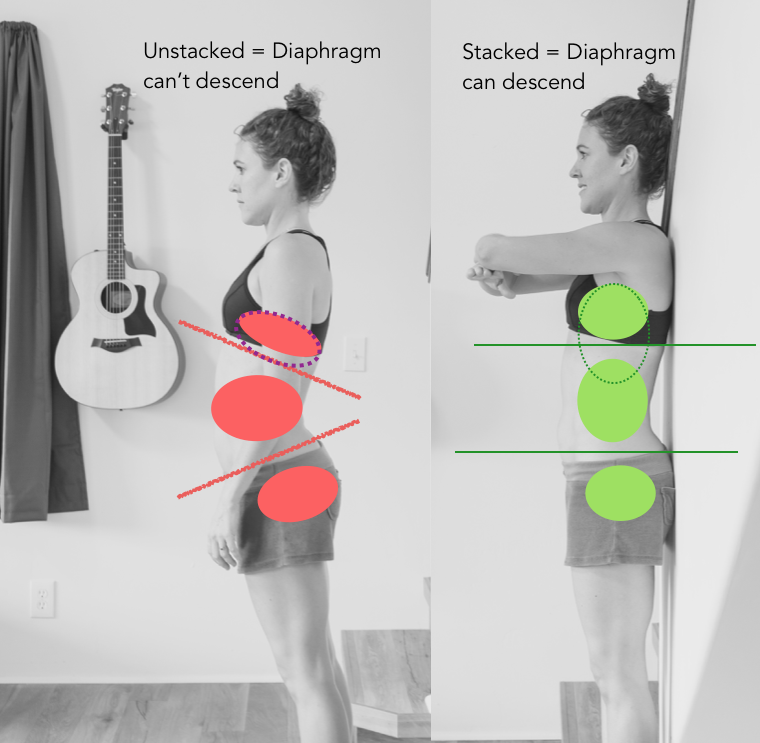Core Function, or Core Dysfunction?
Back in my teens, I thought a strong core meant “ripped abs” … that just hadn’t surfaced yet. In my 20’s, when I was fit as could be, I still thought the core was ripped abs that had now surfaced. Queue knee pain, back pain, and every other pain-in-the-body that also surfaced, partially due to a core that was totally dysfunctional. Yes, it looked great, but it functioned poorly.
Little did I know just how much this core dysfunction could even be making my endometriosis, endo-belly, pain, and fatigue worse. All because my core wasn’t behaving.
If you want to better understand what core dysfunction is, how to know if you deal with it, and a good place to start addressing it, read on!
What is Core Dysfunction?
Here’s the truth: your “core” is more than we’re led to believe. It’ 's not some static tube that attaches our legs to our upper body. It’s actually very dynamic, encompassing the musculature from your shoulders to your pelvis—meaning it’s huge! It’s not just abs in the front, but also glutes and back muscles behind, obliques on the side, and transverse abdominals and a pelvic floor hidden a but deeper inside the trunk.
Your core is responsible for holding you up against gravity. It allows you to poop and pee when needed (rather than incontinence or constipation), have pain-free sex, and lift heavy things without busting the spine. It prevents back pain, allows you to breathe deep, sit, bend, and stand tall. Yes, so much more than abs!
Because the core encompasses so many muscles, it takes communication for them to fire properly. For example, you want your pelvic floor to brace when you sneeze but not when you poop. And you want your glutes to activate to push you up stairs rather than your quads. All of this communication should be done without you (er, rather, that voice in your head) telling it what to do. It should just fire on queue, and relax on queue.
Core dysfunction, then, is when this synchronicity no longer works. This can happen due to tightness or atrophy in some muscles, over strength in others, and even because of nervous system dysregulation (like too much stress). Now you find you breathe shallowly from the upper chest rather than through the ribs and diaphragm. This means your intrabdominal pressure goes up so your pelvic floor is constantly tensing to stop the downward pressure. Too much sitting has weakened the glutes and tightened the hip flexor. It’s all messed up!
This can lead to any number of problems. It could look like sneeze pee, pelvic pain, period pain, shoulder tightness, anxiety, back pain, knee pain, ankle pain, pelvic floor dysfunction, enormous bloating, and more (can you relate to any of these symptoms?).
Core Dysfunction Leads to Pelvic Floor Dysfunction
When your core is no longer working in synchronicity, increased intra-abdominal pressure often occurs, which “squishes” your organs southward.. This may not make sense at first since most of us don’t realize the contents of our abdomen (i.e. our organs) are under pressure at all. It becomes more clear when you think of your abdomen as a sort of well sealed Tupperware, full of your innards but without any holes for air in or out. Yes you have a mouth and a butt, but those aren’t directly connected to the inner contents of your abdomen.
This means your abdomen is a closed off system, and any system closed off to air will be pressurized to some extent - anything from a well-sealed Tupperware container to an air-tight zip-lock is under slight pressure. Thus, this includes your abdomen.
Now, since you must inhale a volume of air into your body, this will add extra pressure into your abdomen by decreasing space for everything else (like, your organs). Because you will indeed be breathing every day for your entire life, your body has some ways to diffuse the increased pressure that happens with every breath - namely through strong and flexible ribs and a dynamic core musculature.
Think about it, you take a breath and your ribs open wide to make room for that air. Cool. Little pressure to speak of.
imagine your organs are punching your uterus and pelvic floor. That’s was increased intra-abdominal pressure does.
HOWEVER, if your ribs don’t budge, your deep transverse abdominals weak, your pelvic floor and tummy tensed, this delicate pressure dance is messed up. What happens instead of a relaxed pressure system is a high-pressure system, and as your lungs bring air into your locked ribcage (stress) and tensed tummy (looking fly in your bikini), there's no where for the pressure to go but down down down to the your lady bits. Check the picture to the right (I edited it a little bit to show you how pressure like this affects your uterus and pelvic floor).
This is how issues like pelvic organ prolapse occur, when parts of your rectum, vagina, uterus, or bladder actually pop out of your vagina, caused by too much pressure from above. While this is often a worst-case scenario, there are also lots of other symptoms such as severe pelvic pain (ahem), sneeze pee, chronic yoga queefing, pelvic pain when getting up from a deep squat, a tipped or retroverted uterus, basic pelvic floor dysfunction, or even painful periods or sex too.
This is why core synergy is SUPER important. When your core isn’t working together the way it should and you're getting tons (and I means tons) of abnormal pressure onto your pelvic floor, endometriosis lesions, cysts, and uterus.
Ouch.
Symptoms of Core Dysfunction: 5 Tests
If you want to check in with your own body and see, you can do a few fun experiments that will shed light on your own core dynamic. Let’s test and see how acquainted your own four amigas are!
Test 1) Cough test
An at home test to see how your abdomen is functioning (or dysfunctioning)?? Yes please! Ok lie down. Put your hands on your belly. Now cough
Did your belly puff outwards, or did it suck slightly in? If it went in, good job! It should suck slightly in as the air is moved OUT of your body. Did it puff out? If so, this means as you displace air out of your body, your diaphragm incorrectly went down, smooshing your organs (including delicate lady parts) downward. This is a sign of current or impending pelvic floor dysfunction. If you're not sure try feeling your belly during a sneeze, this should tell you clearly ;)
Test 2) Movement test
As you’re sitting there reading this, I want you to slowly lift your left arm straight out to the side until it’s shoulder height. There, done? Ok, now check in —— were you holding your breath? Hah, caught you! If you were, this is a good indication you often hold your breath while moving without realizing, showing that your core is not communicating very effectively.
Why should you always be breathing while you move? Because when we hold our breath, we are unknowingly tensing muscles that increase pressure into our bodies (i.e. another punch to the uterus). One of the foundations to healing the pelvic floor and the abdominal wall is to connect all movements to our breath.
Test 3) Check your loaf:
This is one of the best tests ever! Lay on the floor, legs flat, and lift your shirt up so you can see your tummy. First tell her how much you love her, no matter how her TVA behaves. Now, lift your legs up against gravity, using your “core”. Which core did you use, the real strong one or the brittle, pressure inducing one? The way to tell is if your tummy stayed flat(ish) by your hip bones, meaning you engaged your TVA to lift your legs! Good job! If instead you saw a proverbial "loaf" of bread form you actually were using the pressure-powers that be to lift them legs. If you want to see pics check out this this AMAZING BLOG POST that I recommend you read.
In my next blog post I'm going to show you how you may actually be loafing all day long - getting out of bed, out of the car, out of a chair, etc etc. This means you're recruiting pressure to move ya' all day instead of your sexy endo-savior - the TVA. In the meantime, start to watch your "loaf" throughout the day, it's a fun experiment to see how often you find yourself loafing.
Test 4) Stand up straight:
Get a friend with a camera to help you here, because you want a photo of yourself. Now go ahead, or stand up straight, and have someone snap a picture of you doing this. How were you standing? Was your core aligned, with chest, abdomen, and pelvis stacked one on top of another? Or, were you thrusting your chest out and arching your back to appear sitting up straight, all the while shearing your spine?
When your core isn’t connected well, they can't move appropriately. Not only can your diaphragm not descend, but your glutes will be inactive and your pelvic floor tensed to keep you from “falling forward”.
This also shows your TVA isn't strong enough to hold your upper body stable, so you're using your spine to hold you up - ouch :(
4) Lastly, you may be able to physically see it:
Not to bring any body shame into this (because my goal is never to make anyone self conscious) but often you can often see core dysfunction with your own eyes. If your body shape looks like the one on the right, with a prominent lower belly pooch (as mine did at one point), just remember this is often a perfect outline of someone with core dysfunction. This happens from years of incorrect breathing and movement patterns, and an atrophied core.
Want Next Steps to Heal Anew Right Now??
Read this post on endo-belly bloating, and how to start retraining core dysfunction. :)




